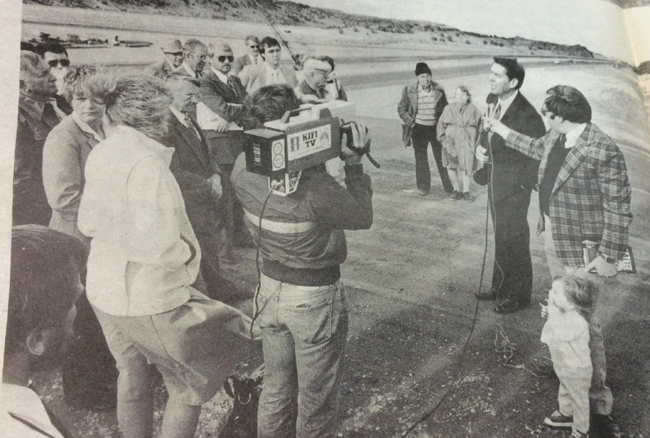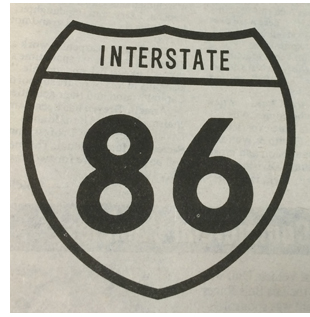

ITD Vault: 30 years ago (Nov. 1985)
Last gap in I-86 dedicated with ceremonies
After a quarter of a century and $33 million, the final 21 miles of Interstate 86 through southern Idaho has been completed.
Gov. John Evans (pictured above) led ceremonies marking the dedication of I-86 between Raft River and the Rockland Junction west of American Falls on Friday, Oct. 11. It was the only section between Pocatello and the Eastern Oregon birder where the federal freeway highway system hadn’t been completed.
The first highway through Idaho and the most historic of the entire Northwest Country was the Oregon Trail, Gov. Evans said. “It is not without significance that the interstate system we are to dedicate today, I-86, largely parallels that route.”
The dedication was also heralded by American Falls mayor Kenneth Morgan, City Councilman Brett Crompton, Sen. Dwight Horsch (pictured below), Transportation Board member John Ohman, and Contract Administration Supervisor Laurence Browning. The American Falls High School Bank also added to the festivities.
A plan to construct a four-lane highway through the area was first conceived in 1952 when the original two lane road, US 30, was built with the intent of serving as the westbound lane.
It was hoped the project would be included in the nationwide interstate project scheduled to begin in 1958. Funding problems and low priority forced state officials to shelve closing the 21-mile gap until 1978. In the past seven years, the Department has awarded eight projects to complete the remaining mileage.
It took over six years to complete the numerous environmental assessments needed prior to beginning construction. The studies help protect a nesting area for wild Whistler Swans, one of the last remaining sections of the Oregon Trail, rooting areas for Bald Eagles, and the adjacent Minidoka Wildlife Refuge. The completed project includes access to Oregon Trail remnants at Clearwater Hill, and by a paved trail under the interstate at Massacre Rocks Rest Area. Saplings and seedlings were planted to provide roosting areas for bald eagles that hunt in the region. Another problem was the preservation of several rock formations through the Massacre Rocks State Park area.
These considerations forced construction crews to carve a roadbed out of lava rock cliffs. That work, according to ITD resident engineer Loren Thomas, caused daily traffic delays. The splitting of rock slope at Register Rock required special caution. Crews were forced to blast next to a 22-inch natural gas pipeline that ran parallel to the route for almost a mile.
Other problems the ITD and contractors solved was the relocation of a 6,500-foot irrigation pipe. The pipe, in its old location, according to Bryant Brown, assistant District 5 Engineer, presented a future maintenance problem for the state. The relocation both solved the problem and improved the irrigation system. The ITD also successfully
negotiated with a farmer who owned land for seven miles on both sides of the interstate. The right-of-way was purchased with a friendly settlement.
“It’s taken 30 years to complete this project,” John Ohman of the Transportation Board said. “But despite all the complications, the project is finished.”
Gov. Evans and American Falls Mayor Kenneth Morgan led the ribbon-cutting ceremony after speeches by Horsch, Ohman and Browning and music by the American Falls High School Band.
Editor’s Note: Dwight Horsch now serves as the District 5 representative on the Idaho Transportation Board. Loren Thomas retired just a few years ago, in 2013. That stretch of road now carries about 6,700 vehicles per day, increasing to more than 10,000 just east of American Falls heading toward Pocatello.
Published 12-04-15